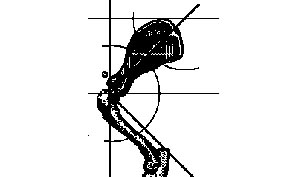
THE BEST SCAPULAR ANGULATION FOR THE MOVEMENT
Still today, countless race patterns exalt the angle of 45°, as ideal, for the inclination of the scapulas with the horizontal, seeking the optimization of the reach of the last of the previous members during the movement.
He/she persists, however, a basic mistake of postulation of the problem in all of the studies already elaborated on the ideal structure for the movement: to study movement considering the dog in station (stopped). With this they get lost countless data that could aid in the study of the biodynamics of the movement.
Here, I intend to include several movements, up to now omitted, that you/they are the one of the own scapula during the exercise of the movement.
1. variation of the angle with the horizontal: 15° forward and 15° back. 2. I move elliptic of the medium point of the crest of the scapula. 3. rising of the crest of the scapula, above the superior line when supporting the paw in the soil to sustain the corporal weight of the observed animal. 4. I move ahead ahead of the whole muscular group of the thoracic belt transporting the scapula in the enthusiasm of improving the reach of the last.
The Shoulder

The scapula is the contact of the member previous with the trunk and the only bone that it is not coupled through articulations. In the bumanos, the scapula pronounces with the clavicle that pronounces with the box toráxica in the manúbrio of the breastbone. In the dogs, the clavicle is atrophied or, even inexistent, but the tendency is the total disappearance.
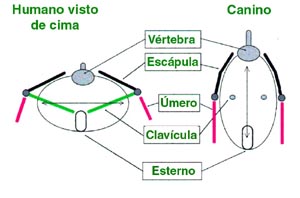
Our box toráxica, has the elliptic format, whose larger axis is among the shoulders, while in the quadruped species, exactly for they be quadruped the larger axis is between the vertebral spine and bone breastbone.
In the humans the scapula works in the backs, in the canine teeth, she is an annoying and curved bone shaped perfectly to the format of the thoracic box's lateral faces, providing the slippery movement among the muscles that sustain her/it against the thorax.
That muscular compound, call of belt toráxica sustains, without fastening, the scapula in his/her position, forming an articulation a lot sigular, mioartrose or muscular articulation.
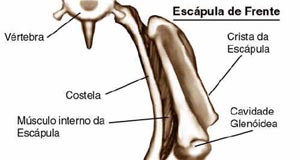
The scapula, with his/her format special, flat and modeled to the thorax, it possesses a spine in his/her face expresses disposed along his/her largest length and that it divides her/it in two metadas, practically same, of great surfaces for insert and architecture of a compound system biomecânico of muscles suspenders and shock absorbers, whose distribution has orígem in 3 main directions: neck, back / ribs and previous members.
That flat format and shaped to the thorax, it allows his/her work close to the trunk, free, without articulations, in slippery movements to the flavor of the contractions and muscular relaxations.
In the articulation with the humerus, his/her part more reinforced, the scapula works as a capitel of Greek column, that it sustains much more than the half of the corporal weight of the dog.
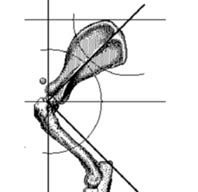
For the maximum use of the effort, the spine of the scapula would owe, second most of the race patterns, to do an angle of 45° with the horizontal, angle that, that he/she would offer, to the humerus the largest width of the movement pendular of the previous member, to the front and, as consequence larger immediate last width.
The ideal value of 45° is debatable, once they are rare the copies whose disappear-horizontal angulation has that value and, the ones that introduced him/it, they didn't demonstrate good income in the movement.
H á that to be observed that the hipismo existed before the cinofilia, whose first race patterns were written by hipistas, with equine parameters, the ones which, for his/her time they were elaborated to the light of the human anatomy.
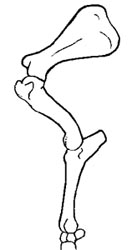
The equine structures that you/they gave right, they were studied for animal species of great load, with an approximate weight from 500 to 600 kilos. The heavier canine species reach about 10% of that value.
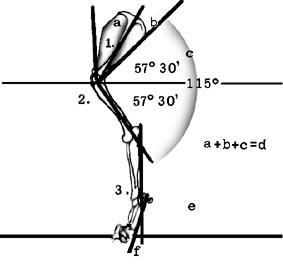
In the canine species, the cinologia observed that the copies of better income, in the trot, presented a value around the 50° to 60° for the disappear-horizontal angulation.
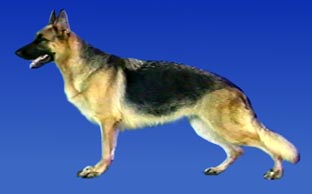
The Dog in Station
The angle, that the scapula does with the horizontal, has very little importance for the dog in station, if the objective is the optimization of the reach ahead, of the previous members, during the movement.
In fact, the whole theory presented by McDowell Lyons, it considered, for their hypotheses the dog in station.
|
|
|
The illustrations of comparative Lyons among the sloping scapulas to 45° and 60° to lecture on the efficiency of the reach of the last of the previous ones never considered the possible movements of the scapula.
Lyons commits the absurdity of affirming that the fact of the scapula to be tilted to 45° increases his/her size providing a larger area for the insert of muscles, in the place of comparing two scapulas of same size, varying, just the inclination angle.
The second great geometric mistake happened when Lyons tried to analyze, separately, the scapular movements setting up his/her hypothesis with the only objective of proving that the angle of 45° was" from a distance superior to the of 60th":
1. 45° correspond to the diagonal of the square. 2. 60°, geometrically, it corresponds to the diagonal of a rectangle and the hypotenuse of the two triangles formed rectangles, therefore, 15% larger than the diagonal of an enrolled square (trigonometry). 3. An exempt analysis should suppose two different inclinations, 45° and 60° for the same scapula, in the place of affirming that 60° check a smaller arch, declaring the largest geometric absurdity. 4. To reinforce his/her absurd affirmative, without trigonometrical base, it shows that the scapula to 60° describes a smaller arch (F) that one with angle of 45° when the scapula at least gyrates only around a theoretical axis because her, as own Lyons is not fixed for articulation and yes, for musculature.
When, during the movement (and not in station) the paw looks for a position more ahead the possible, the scapula should assume the angle of 45°, and, to take that member back, the angle of the scapula, with the horizontal should approach the 90°, that is almost vertical.
So that this can happen, the angle of the scapula with the horizontal, when the dog is in station should be around the 57° to 60°.
The scapular movement is not, like this, so reduced that it can be despised.
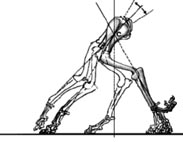
Gyrating on the theoretical axis (C), in the center of the largest size of the spine of the scapula.
In the movement of the member to the front, the scapula gyrates, in sense schedule, about 15°. In the movement the scapula gyrates back, in counterclockwise sense, about 30°.
There is, although it takes in consideration the fact that all of the authors describe the scapula as not being articulated any of the trunk with bone, but sustained for complex muscular, complex that that allows to the theoretical axis (C) an elliptic movement.
The crown of the scapula appears several times above the superior line during the movement.
To compute that elliptic movement, it would complicate the calculation of the angulation escápuloumeral taken with the dog in station.
However, it is exactly that, the movement that allows to the dog to accomplish the force tratora, in the apex of the escalade of a ramp of obstacles, to put him/it on the other side. The muscles that accomplish that healthy work the one of insert in the scapula.
The crown form that we called withers and the tip of the scapula, whose cavity glenódea pronounces with the humerus, forms the tip of the shoulder and the vertex of the angulation escapuloumeral. In a shoulder well built, the distance of the crown of the scapula to the tip of the shoulder should be approximately equal at the distance of the tip of the shoulder to the elbow.
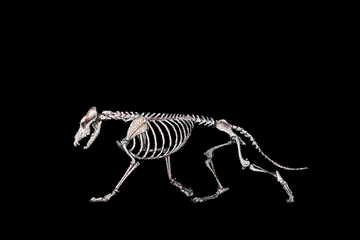
A Articulação Escapuloumeral
One cannot speak about modification of the scapular angulation without doing an analysis of the angulation escapuloumeral with the values of a new situation of the scapula.
1. It is necessary to do the bills. The bisector of the angle between the crest of the scapula and the axis of the humerus should be horizontal. For this to happen, the angulation escapuloumeral should always be the double of the angle of the scapula with the horizontal. In other words the angle that the humerus should do with the horizontal it is identical to the angle of the scapula.
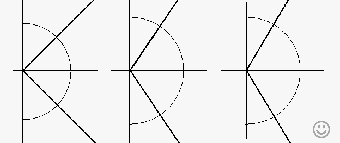
The old pattern of the race Rottweiler extolled an angle of 90°, for the articulation escápulo-umeral, and of 45° the one of the scapula with the horizontal.
When they noticed that Rottweiler would never have an escápulo-umeral of 90°, same because, if they got would seem crippled, they changed for 115°, but they forgot to revalue the escápulo-horizontal, that it stayed in the 45°.
The difference: 115° - 90° = 25° now, 45th + 115th = 160th, then, the humerus would do, with the vertical, an angle of, only 20° that it is the difference with the sum of two right angles: 180°: 180° - 160° = 20°
To balance, again the system, the real angle with the horizontal should be substituted of 45° for, around 57° or, even, around the 60°. The theory that says that the ideal scapula is to 45° with the horizontal, be just passed, because all of the calculations done up to now on the ideal scapular angulation for a fluent movement with larger reach last were done considering the dog in Stay forgetting, completely, that:
1. the scapula pronounces with the thorax through musculature (it belts thoracic); 2. during the movement, the scapula develops a path pendular, oscillatory around an axis; 3. that axis, for his/her time, describes an elliptic movement, causing the emergence of the crest of the scapula above the line several superior times during the trot. 4. the inclination of the spine of the scapula, resultant of those movements, oscillates around the 45th; 15° ahead and 30° for trás.
Like this, with the scapula to 60° in stay, in his/her position it exalts for ahead, (-15°) the angle of the spine of the scapula reaches the ideal angulation of 45°.
The German creators are in the right road, it only remains to correct the escápulo-horizontal angle (in the text, because indeed, the dogs already have them correct, only that lack is being considered).
The conclusion that she arrive is that the best angulation for the scapula is really the one of 45° WHEN IN MOVEMENT AND the POSITION OF THE MEMBER, MAXIM ahead
And, to be in this position, it is necessary that, stopped the dog has an angulation disappear umeral from 115th to 120° and an angulation disappear horizontal of half value 57° to 60°
Bruno Tausz - Etólogo